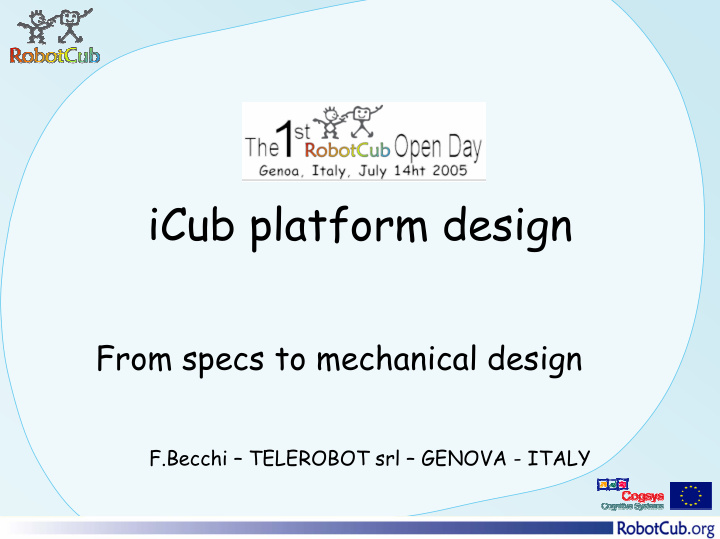



iCub platform design From specs to mechanical design F.Becchi – TELEROBOT srl – GENOVA - ITALY
From normotype to a 3D common reference model All must fit in the model !
Platfom weight definition From different experiences on robotics and common “a priori” evaluation a total weight goal with sub group weight distribution is defined
First simulations and first results • Work done at EPFL gives to mechanical engineers reference performances for the actuator selection and the design task
By merging each group different experience we defined a common motors and gearboxes data base: •Faulhaber; •Maxxon; •Portescap; •Wittenstein; •Gysin; •Harmonic drive; •…
•First limitation in the design is the POWER DENSITY for motors •Second limitation in the design is the stress level in the mechanics (eg. max torques on gears…) BOTH are phisical limits connected to the aivalable technology BEST COMPROMISE SOLUTION NEEDS TO BE DEFINED
In the first discussions several possible approach were outlined in the design: • Serial joint design; • Pairs of toothed gears; • Tendon driven desing; • Parallel mechanics design; • Underactuated design. Each group has investigated pros and cons of different approach..
The work team The mechanical design of the iCub is spreaded over 4 groups: • IST (lisbon) is responsible for the head design; • SSSA (pisa) is responsible for the hand, arm and upper torso design; • USAL (salford) is responsible for the waist, lower body and leg desig; • TLR+UNIGE-LIRA (genova) is responsible for the design coordination and integration. And the whole robotcub consortium contribute strongly to the design..
Reviewing some sub group at the current development state will show several different approach tailored on the application : • The serial design of the neck (IST); • The underactuation and tendon relocation in the finger design (SSSA); • The cable driven waist joint on a differential design (USAL).
Head design (IST) From sketch to cad
Head design (close view) 3 DOF serial neck modular design indipendent vergency (2dofs) eye tilt overload protection on neck absolute sensors on neck integrated sensors and electronics
Arm/Hand design (SSSA) 3 DOF shoulder timing belt driven 1 DOF elbow conical gear driven 3 DOF wrist(mixed transmission) hand actuator relocation along the arm
Arm/Hand design (SSSA) 9 controlled DOF on hand finger underactuation (21 DOF in total) absolute position sensor on finger joint tension sensor on finger tendons tactile sensor (still under implementation)
Finger design (close view)
Lower body (USAL) 3 DOF waist 3 DOF hip on each leg 1 DOF knee rotation 2 DOF ankle (under development)
Waist design (USAL) 3 DOF central body joint 2 DOF differential tendon driven 1 DOF pan rotation Force sensors directly integrated in wheel design Absolute position sensors (potentiometer)
Waist design (close view)
..design evolution
..the integration task:first attempt (march 05)
..the integration task (current status)
..the integration task (current status) 1. Task to be done: solve subgroup level problems trough prototipe realization and hard test; solve fit in and weight concerns problems; solve internal space sharing problems; standardization of components used and possibly of technology ..make it all work fine!
..the integration task ..maybe next time!
..thank-you.. francesco.becchi@robotcub.it www.telerobot.it
Recommend
More recommend